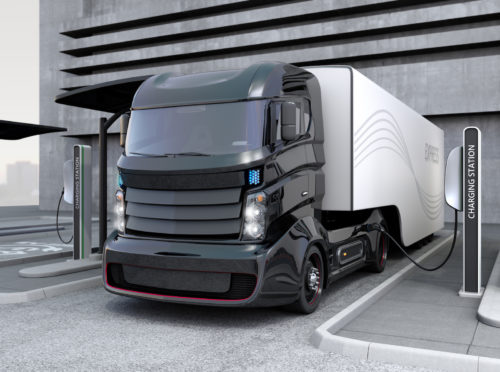
The Electric Vehicle Charging No One’s Talking About (But Should Be!)
Prioritizing Regional Haul Routes for Heavy-Duty Electric Vehicle Charging Infrastructure
There’s been a lot of talk around green stimulus lately. In the face of the COVID-19 pandemic and the associated economic downturn, organizations across the country have recently proposed federal programs that promise to create jobs, jumpstart the economy, and support public health, all while reducing US greenhouse gas (GHG) emissions.
And there’s one thing that many of these proposals—including those from Rocky Mountain Institute (RMI), Data for Progress, Transportation Electrification Partnership, and Securing America’s Future Energy—have in common: they all include efforts to decarbonize the transportation sector, particularly by transitioning from internal combustion engines to electric vehicles. One segment that is ripe for this change is regional haul trucking, which means it’s crucial to start thinking about where and how to prioritize infrastructure investments for these short return-to-base operations.
Trucking Goes Electric
Earlier this month, the House Transportation Committee unveiled a nearly $500 billion green infrastructure bill dubbed the INVEST in America Act, which includes investments in EV charging stations. And while for many, the term “EV” tends to conjure images of passenger vehicles like the Tesla Model S or Nissan Leaf, electrification is coming to the medium- and heavy-duty vehicle world as well.
Commercial fleets are increasingly considering zero-emissions trucks for their freight hauling operations as new models go into production and upfront purchase prices come down. In fact, product availability is improving rapidly. In the heavy-duty North American market alone, 19 zero-emission truck models (either battery electric or hydrogen fuel cell), from 14 manufacturers, are expected to be in production within the next three years. This represents an impressive 280 percent increase in the five Class 8 models commercially available today.
This is great news for the climate since transportation is now the nation’s single largest source of GHGs, accounting for 29 percent of GHG emissions. Nearly a quarter of those emissions come from medium- and heavy-duty trucks—more than two-and-a-half times the amount that comes from aviation. In addition to GHG emissions, pollution from tailpipes, tires, and brakes reduces air quality, increasing smog and particulate matter in the air and harming communities, particularly lower-income communities of color, who, due to discriminatory housing practices and environmental injustice, tend to live near highways and logistics hubs.
This inequity has particularly disastrous impacts during a health crisis like COVID-19. In fact, new research from Harvard shows that an increase of one unit of fine particulate matter is associated with an increase of 8 percent in COVID-19 death rates. Needless to say, it is beyond time to clean up road-based goods transportation. But with limited resources available— both from the public and private sectors—questions are raised around which sectors and regions make the most sense to electrify first.
Regional Haul Needs Charging Infrastructure Too
Although the industry has begun electrifying medium-duty urban delivery applications—with companies such as UPS and FedEx already starting to pilot the technology—RMI and the North American Council for Freight Efficiency (NACFE), through their extensive work on electric trucks and regional haul, have discovered that regional trucking operations are also suited to be early adopters of electric trucks, given the segment’s relatively short-haul nature and return-to-base operations. They tend to have predictable destinations and consistent mileage, which means that range isn’t as much of a challenge as compared to, say, long haul, and that it’s relatively straightforward to know where to build out charging infrastructure.
We expect regional haul fleets to charge mostly at home bases, similar to the vast majority of light-duty EV owners. As the Run On Less Regional analysis concluded, their return-to-base operations—no matter their duty cycle—are a key factor in making this segment ideal for electric trucks. The Run On Less Regional team defined three major categories of regional duty cycles as follows:
- A-B-A, where the truck goes out to the same location and returns to base, doing this once or several times in a driving shift.
- Hub-and-spoke, which is like A-B-A, but has different B locations over a day, week, or month.
- A-B-C-D-A, where there are multiple pick-ups and deliveries over the course of the route with the vehicle still returning to the same base.
Fleets identified lack of charging infrastructure at facilities as one of the top barriers to electrifying their fleets. But investing in that infrastructure makes a lot of sense for fleets with regional haul operations because the trucks are guaranteed to return to the facility, so fleets can have confidence that any charging infrastructure they invest in will be highly utilized by their vehicles, particularly as they grow their electric truck deployments.
Furthermore, regional haul routes are increasing, according to a variety of trends impacting freight movement, as discussed in NACFE’s 2019 Regional Haul report. Therefore, investing in the infrastructure to support electrification of this segment will likely see large returns in the years to come as the economic and policy cases for electric vehicles continue to increase.
Unique Charging Needs
But charging a heavy-duty truck is quite different from charging a passenger vehicle, perhaps most notably in the difference in charging levels. While many personal EV owners are able to charge using a regular wall outlet in their garage or potentially a Level 2 charger in the ballpark of 7 kW, heavy-duty trucks tend to require much higher power levels.
Depending on the size of the vehicle’s battery, the state of charge at the end of a shift, and the amount of dwell time available for charging between shifts, these vehicles may require DC fast charging (DCFC) involving power levels of over 150 kW. In fact, the industry is currently working to standardize high power charging for commercial vehicles, expecting power levels over 1 MW in the not-too-distant future.
It can be quite expensive to generate and deliver this amount of power, particularly on the “make ready” infrastructure side, which includes expenses such as service line and transformer upgrades, trenching, conduit, and conductors. The charging stations themselves can be quite pricey as well. An expert from the California Air Resources Board (CARB) recently estimated that, all in, charging infrastructure alone currently costs approximately $100 thousand per vehicle for battery electric freight trucks. That is a hefty bill, even for large fleets, particularly when you consider that the upfront purchase price of the electric trucks themselves is still two to three times as expensive as a traditional diesel-powered truck.
Given the price tag, it’s not difficult to see why fleets prioritize electric truck deployments in regions where funding incentives, such as loans, grants, rebates, and tax credits are available – both for vehicles and infrastructure. But what else should fleets, utilities, and policymakers consider when deciding where to prioritize infrastructure investments to support regional haul electric truck deployments? Stay tuned for our upcoming Insight Brief!

